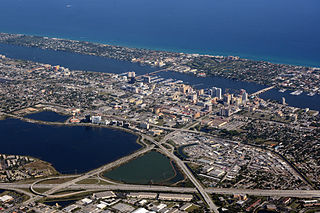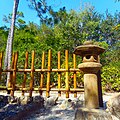
Boca Raton is a city in Palm Beach County, Florida, United States. The population was 97,422 in the 2020 census and it ranked as the 23rd-largest city in Florida in 2022. However, many people with a Boca Raton postal address live outside of municipal boundaries, such as in West Boca Raton. As a business center, the city also experiences significant daytime population increases. Boca Raton is 45 miles (72 km) north of Miami and is a principal city of the Miami metropolitan area, which had a population of 6,138,333 at the 2020 United States Census.

Palm Beach County is a county in the southeastern part of Florida, located in the Miami metropolitan area. It is Florida's third-most populous county after Miami-Dade County and Broward County and the 26th-most populous in the United States, with 1,492,191 residents as of the 2020 census. Its county seat and largest city is West Palm Beach, which had a population of 117,415 as of 2020. Named after one of its oldest settlements, Palm Beach, the county was established in 1909, after being split from Miami-Dade County. The county's modern-day boundaries were established in 1963.

Japanese gardens are traditional gardens whose designs are accompanied by Japanese aesthetics and philosophical ideas, avoid artificial ornamentation, and highlight the natural landscape. Plants and worn, aged materials are generally used by Japanese garden designers to suggest a natural landscape, and to express the fragility of existence as well as time's unstoppable advance. Ancient Japanese art inspired past garden designers. Water is an important feature of many gardens, as are rocks and often gravel. Despite there being many attractive Japanese flowering plants, herbaceous flowers generally play much less of a role in Japanese gardens than in the West, though seasonally flowering shrubs and trees are important, all the more dramatic because of the contrast with the usual predominant green. Evergreen plants are "the bones of the garden" in Japan. Though a natural-seeming appearance is the aim, Japanese gardeners often shape their plants, including trees, with great rigour.
The Roji-en: Garden of the Drops of Dew, The George D. and Harriet W. Cornell Japanese Gardens consists of six gardens representing different periods in the development of the Japanese garden. It occupies 16 acres of the Morikami Museum and Japanese Gardens in Morikami Park in suburban Delray Beach, Florida, USA. The gardens are open to the public, but closed Mondays and major holidays. Access to the gardens is included in the admission fee to the museum.

The Fort Worth Japanese Garden is a 7.5-acre (3.0 ha) Japanese Garden in the Fort Worth Botanic Garden. The garden was built in 1973 and many of the plants and construction materials were donated by Fort Worth's sister city Nagaoka, Japan. Attractions at the garden include a zen garden, a moon viewing (tsukimi) deck, waterfalls, cherry trees, Japanese maples, a pagoda, and fishfood dispensers to feed the hundreds of koi in the Japanese Garden's three ponds. The garden hosts two annual events, the Spring Festival and the Fall Festival, featuring demonstrations of Japanese art and culture.
The Yamato Colony was an attempt to create a community of Japanese farmers in what is now Boca Raton, Florida, early in the 20th century. With encouragement from Florida authorities, young Japanese men were recruited to farm in the colony. There were as many as 75 Japanese men, some with their families, at the peak. There was "a cluster of two-story frame houses, a general store..., some packing houses."

Sukeji "George" Morikami was a Japanese immigrant to the United States who farmed in Palm Beach County, Florida, for more than 65 years. He donated his 200 acres of farm land to Palm Beach County in 1973.

Boca Raton Airport is a state-owned public-use airport located two miles (3 km) northwest of the central business district of Boca Raton, a city in Palm Beach County, Florida, United States. The airport is immediately adjacent to Florida Atlantic University and to Interstate 95.

The American Orchid Society Visitors Center and Botanical Garden was a 3.5 acres (1.4 ha) botanical garden specializing in orchids and home to the American Orchid Society. The facility was located in Morikami Park at 16700 AOS Lane, Delray Beach, Florida, United States, and included a 4,000 square foot greenhouse open to the public. The visitor center was a 20,000 square foot (1,900 m2) Mediterranean style building that was designed by Song Associates of West Palm Beach, Florida. There were 3.5 acres (1.4 ha) of gardens with a design adapted from work by students at the University of Florida's Department of Landscape Architecture by Connie Roy-Fisher Landscape Architects of Jupiter, Florida.
Yamato Colony can refer to some places in the United States:
Hoichi Kurisu is a noted designer of Japanese gardens, active in the United States.

Military Trail is a 46.2-mile (74.35 km) long six-lane north–south arterial road in Broward and Palm Beach counties in South Florida. A portion of the road is designated State Road 809 (SR 809), but most of the road within Palm Beach County is locally maintained and signed as County Road 809 (CR 809), while the Broward County section exists without either designation.

Palm Tran is the public transit bus system run by the Palm Beach County Government, serving Palm Beach County, Florida. In 2023, the system had a ridership of 8,612,200, or about 29,600 per weekday as of the fourth quarter of 2023. Palm Tran also serves a portion of Broward County, Florida where it overlaps with Broward County Transit. Palm Tran has four main facilities with its main headquarters in West Palm Beach on Electronics Way. The current executive director is Clinton B. Forbes.

Boca Raton Army Air Field was a World War II United States Army Air Forces airfield, located 1.7 miles (2.7 km) northwest of the 1940s borders of Boca Raton, Florida. During World War II, it operated the only training for the then new and secret technology of radar. Closed in 1946, due to annexation the former base is now within the city of Boca Raton; the land is currently occupied by the Boca Raton Airport, Florida Atlantic University and Palm Beach State College.
The Virginia Slims of Florida is a defunct WTA Tour affiliated tennis tournament played from 1984 to 1995 in various locations in Florida in the United States. It was held at the Frenchman's Creek Beach & Country Club in Palm Beach Gardens in 1984, at Crandon Park in Key Biscayne from 1985 to 1986, at the Polo Club in Boca Raton from 1987 to 1992, and at the Delray Beach Tennis Center in Delray Beach from 1993 to 1995. The tournament was played on outdoor clay courts in 1984 and on outdoor hard courts from 1985 to 1995.

Delray Beach is a city in Palm Beach County, Florida, United States. The population of Delray Beach as of April 1, 2020 was 66,846 according to the 2020 United States Census. Located in the Miami metropolitan area, Delray Beach is 52 miles north of Miami.
The Museum of Lifestyle & Fashion History is a non-profit organization located in Palm Beach County, Florida. Currently the museum is seeking a permanent location.
West Boca Raton, also known as West Boca, is an unincorporated community west of the city of Boca Raton, Florida. It is populated by numerous developments such as Boca Landings, The Hamptons, Mission Bay, Sandalfoot Cove, Century Village, and Loggers' Run.

The Boca Raton Historical Society & Museum is a non-profit organization and public museum dedicated to preserve and collect history and artifacts of Boca Raton, Florida, United States, for educational and advocacy purposes. The society is known for their goal of historic designation and restoring historical structures important to the history of Boca Raton. The society offers exhibits, lectures, lessons, history tours, and educational programs to achieve their goal. Many interactive educational programs and services of the society are provided to schools, teachers, and children to help educate Florida's history. Additionally, the community provides a library of collected and preserved artifacts, photographs, newspapers, diaries, reference books, and research papers documented for educational and research purposes. The historical society has been a contributor of researching local history of Florida and Boca Raton and offers scholars, educators, university graduates and interns access to their research collection and publications, such as the Spanish Papers. The Boca Raton Historical Museum is publicly open from Monday through Friday from 10am to 4pm.



























